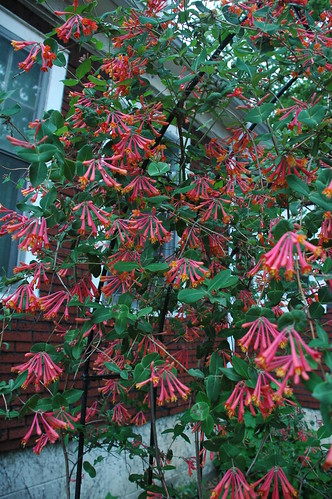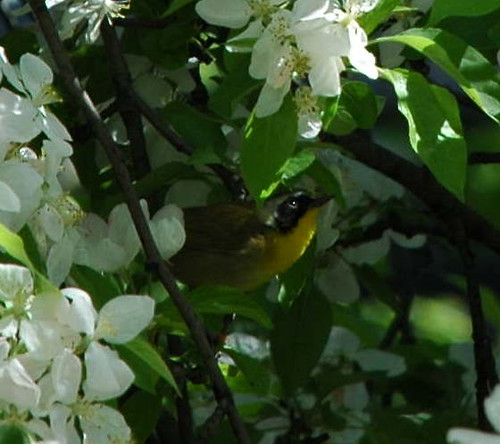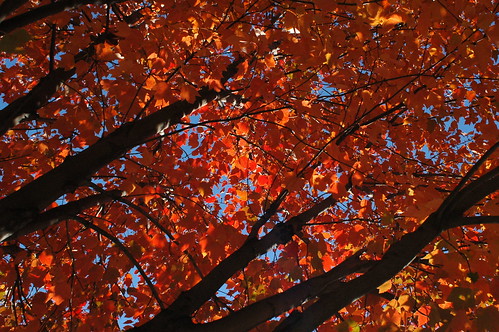Sassafras albidum, Sassafras, is a medium-sized deciduous tree native to eastern North America. It’s easily identified by its leaves which vary in shape from simple (unlobed) and elliptical, asymmetrically two-lobed (left- or right-handed “mittens”), and three-lobed.
Two forms of Sassafras leaves. Photo: Patrick Coin (Flickr)

Several features of Sassafras led me to select it as the focal point for my backyard garden design planting plan. Although I’ve lived in the Northeast most of my life, it’s only in the past several years that I’ve come to really appreciate Sassafras. I now recognize it as a four-season plant.
In early Spring, before anything leafs out, the clouds of brilliant yellow flowers stand out; both male and female flowers are colorful. Summer foliage is handsome and aromatic. On female plants, the fruit is colorful and attractive, and the red stems persist after the fruit has been devoured by birds. Fall color is among the best there is; it should be part of any fall garden that has the space for it. For winter interest, the bark of older specimens develops interesting textures, while the forms of the bare branches seem to flail chaotically, expressive of wilderness.
Sassafras albidum, typical autumn coloration. Photo: dogtooth77 (Flickr)

Sassafras is in the Lauraceae, the Laurel family. This is a family of mostly pantropical, evergreen shrubs and trees; Sassafras has the most northern distribution of the Lauraceae. Many plants in this family are rich in essential oils, and thus of economic importance; Cinnamon, Bay Laurel and Avocado are also in this family. Sassafras roots were once used to flavor root beer, until concerns about the carcinogenic properties of safrole led to banning its use. Sassafras leaves are still used to make the spice gumbo filé.
All parts of Sassafras are aromatic, including its leaves. It’s an important larval host for several Lepidoptera. It’s the primary larval host for Papilio troilus, spicebush swallowtail, P. palamedes, laurel swallowtail, and Callosamia promethea, Promethea silkmoth.
Flowers are pollinated by bees and flies. Sassafras fruits are eaten by many species of birds. However, plants are dioecious, so both male and female plants are needed within pollinator range. Even if I was lucky enough to get a female plant, the closest other plants I’m aware of are in Prospect Park, a half-mile away. I’m not counting on fruit from my Sassafras, but it would be a terrific bonus.
From my observations, it’s very common in the sandy soils along the New Jersey coast. It’s most common as a successional plant in disturbed areas, where it can form pure stands through suckering. There’s been some research to indicate that Sassafras exhibits allelopathy, interfering with the germination of some other woody species, at least.
A tendency toward suckering and a reputation for difficulty in transplantation have limited its application in cultivation. However, several authors suggest that propagation methods may influence this. Specimens propagated by apparent transplantation from the field may actually be suckers being separated from a parent plant or stand. The thought is that this increases the chance for suckering later, after transplantation. Even true individuals have deep taproots, making transplantation difficult. This obstacle can be eliminated with pot-grown, seed-propagated individuals. I’m on the lookout for a retail source in the NYC area.
Taxonomy
Botanical name: Sassafras albidum
Family: Lauraceae (Laurel Family)
Common name: Sassafras
Description: Deciduous tree.
Range: Widespread in eastern North America, from Maine to Ontario and Michigan, south to Florida and eastern Texas.
Features
Flowers: Bright yellow clusters of flowers appear before leaves in early Spring. Dioecious: both male and female plants needed for fruiting.
Foliage: Multiple shapes, brilliant fall colors, one of the best for fall foliage.
Fruits: (On female plants) Oil-rich, blue-black berries on long bright red stalks.
Bark: Smooth when young, interesting, deeply furrowed, “alligator-hide bark” [Cullina] on older trees.
Culture
Height: 8m/26ft after 20 years [Flint], 30-60 feet at maturity
Width: 25-40 feet at maturity
DBH: 3 feet at maturity
Hardiness zones: 4-8
Exposure: Full sun preferred, but tolerates some shade as an understory tree.
Water: Drought-tolerant
Longevity: The Arnold Arboretum has a specimen that they acquired in 1884, over 120 years ago.
- Because of its wide natural range, select a local ecotype, or acquire from a local nursery, for best adaptation and performance to your conditions.
- Can be prone to suckering from lateral roots. To minimize this, do not transplant from the wild. Plant only container-grown seedlings. [Cullina, DIRR1997, Flint]
- Not readily available commercially, but is carried by nurseries specializing in native plants.
- Dioecious, so an individual planting may be male or female, and both are needed to produce fruit on the females.
- Allelopathic.
Wildlife value
Birds: Oil-rich fruit on female plants are favored by migrating birds. [Cullina] Species include catbirds, flickers, pileated woodpeckers, downy woodpeckers, thrushes, vireos, and mockingbirds.
Butterflies and Moths: Primary larval host for Papilio troilus, spicebush swallowtail, P. palamedes, laurel swallowtail [Cullina, NPIN], and Callosamia promethea, Promethea silkmoth [NPIN, BONA], Cecropia species [BBG]
Pollinators: Sassafras is pollinated by bees and flies.
[tinyurl]
References
[BONA] Butterflies and Moths of North America
Cullina, William. Native Trees, Shrubs and Vines. 2002. Houghton Mifflin. ISBN-13: 978-0-618-09858-3
[DIRR1997] Dirr, Michael. Dirr’s Hardy Trees and Shrubs. 1997. Timber Press. ISBN-13: 978-0-88192-404-6
[DIRR1998] Dirr, Michael. Manual of Woody Landscape Plants. Revised 1998. Stipes Publishing. ISBN-13: 978-0-87563-795-2
Flint, Harrison. Landscape Plants for Eastern North America. 1983. Wiley. ISBN: 0-471-86905-8
NPIN
Sullivan, Janet (1993). “Sassafras albidum“. Fire Effects Information System, [Online]. U.S. Department of Agriculture, Forest Service, Rocky Mountain Research Station, Fire Sciences Laboratory
Links
Floridata
Missouri Botanical Garden
Plants For A Future
PLANTS, USDA
University of Connecticut
Wikipedia
Wikibooks
























